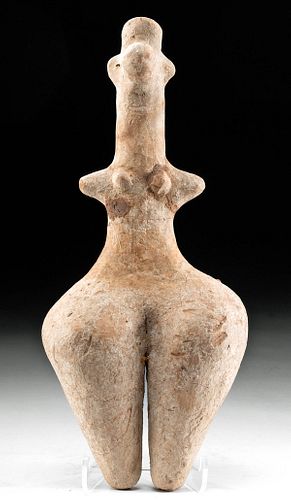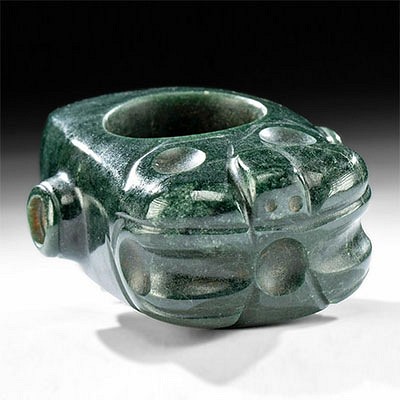Amlash Terracotta Steatopygous Female Idol Figure
Lot 54
About Seller
Artemis Fine Arts
686 S Taylor Ave, Ste 106
Louisville, CO 80027
United States
Selling antiquities, ancient and ethnographic art online since 1993, Artemis Gallery specializes in Classical Antiquities (Egyptian, Greek, Roman, Near Eastern), Asian, Pre-Columbian, African / Tribal / Oceanographic art. Our extensive inventory includes pottery, stone, metal, wood, glass and textil...Read more
Categories
Estimate:
$3,500 - $5,000
Absentee vs Live bid
Two ways to bid:
- Leave a max absentee bid and the platform will bid on your behalf up to your maximum bid during the live auction.
- Bid live during the auction and your bids will be submitted real-time to the auctioneer.
Bid Increments
| Price | Bid Increment |
|---|---|
| $0 | $25 |
| $300 | $50 |
| $1,000 | $100 |
| $2,000 | $250 |
| $5,000 | $500 |
| $10,000 | $1,000 |
| $20,000 | $2,500 |
| $50,000 | $5,000 |
| $100,000 | $10,000 |
| $200,000 | $20,000 |
About Auction
By Artemis Fine Arts
Sep 10, 2020
Set Reminder
2020-09-10 10:00:00
2020-09-10 10:00:00
America/New_York
Bidsquare
Bidsquare : Antiquities | Asian | Ethnographic Art
https://www.bidsquare.com/auctions/artemis-gallery/antiquities-asian-ethnographic-art-5546
Featuring classical antiquities, ancient and ethnographic art from cultures encompassing the globe. Egyptian, Greek, Roman, Etruscan, Near Eastern, Asian, Pre-Columbian, Native American, African / Tribal, Oceanic, Spanish Colonial, Russian, Fossils, Fine Art, more! Artemis Fine Arts info@artemisgallery.com
Featuring classical antiquities, ancient and ethnographic art from cultures encompassing the globe. Egyptian, Greek, Roman, Etruscan, Near Eastern, Asian, Pre-Columbian, Native American, African / Tribal, Oceanic, Spanish Colonial, Russian, Fossils, Fine Art, more! Artemis Fine Arts info@artemisgallery.com
- Lot Description
Ancient Near East, northwestern Iran, Amlash culture, ca. late 2nd to early 1st millennium BCE. A hand-built and highly burnished terracotta steatopygous idol depicting an abstract female standing upon delineated legs. The nude, characteristically minimalist figure exhibits voluptuous thighs symbolic of child bearing and fertility, a slender waist representing the ideal feminine figure, and attenuated arms that flank a pair of perky breasts. Surmounting the elongated neck is a spherical 'bird-like' face with a pair of pierced ears that perhaps once held additional ornamentation as well as a high hair ornament with a pinched brim. Traces of orange and orange-brown pigment visible across the figure suggest this example was embellished with vibrant pigments at one time. A sizable example of a steatopygous figure from the ancient Amlash! Lucite display stand for photography purposes only. Size: 4.125" W x 9.6" H (10.5 cm x 24.4 cm)
Bird-faced steatopygous idol figures like this example have been uncovered throughout northwestern Iran and the southwestern areas of the Caspian Sea and are some of the region's most enigmatic artifacts. Steatopygous idols as a figural category are understood to be symbolic of fertility, virility, and human sexuality, however the specific symbolic interpretation of these idols cannot be condensed quite so easily. Most steatopygous idols discovered in the late nineteenth and early twentieth centuries were found largely by male archaeologists who, upon their observations of the feminine features, immediately associated them with the "fertility idol" moniker. More recent interpretations of these idols have partially debunked this, however, as the nuances of different figural styles were found to relate less to broad associations with fertility and more with varied symbolism of the individual figure. Such scholarly re-interpretations have posited that different styles could perhaps be identified as or associated with a familial matriarch, a religious worshipper, or a female goddess in her corporeal form.
For a stylistically similar example with longer arms and lower legs, please see "Idols: The Beginning of Abstract Form." Ariadne Galleries, Inc., London, 1989, cover (second from left) & p. 108, fig. 117.
A nearly identical example, of a shorter size, hammered for EUR 8,750 ($9,732.93) at Christie's, Paris "Archeologie: Collection Pierre et Claude Verite" auction (sale 1063, December 20, 2011, lot 9).
Provenance: ex-Alfred Stendahl collection, owner of Stendahl Gallery, Los Angeles, California, USA, acquired before 1980
All items legal to buy/sell under U.S. Statute covering cultural patrimony Code 2600, CHAPTER 14, and are guaranteed to be as described or your money back.
A Certificate of Authenticity will accompany all winning bids.
We ship worldwide and handle all shipping in-house for your convenience.
#153804Repaired from multiple pieces, with restoration to areas of butt, waist, neck, and face, and resurfacing with overpainting along new material and break lines. Abrasions and nicks to legs, body, neck, and head, with encrustations across most surfaces, fading to original pigmentation, and a few stable hairline fissures. Nice earthen deposits and faint remains of original pigment throughout.Condition
- Shipping Info
-
All shipping is handled in-house for your convenience. Your invoice from Artemis Gallery will include shipping calculation instructions. If in doubt, please inquire BEFORE bidding for estimated shipping costs for individual items.
-
- Buyer's Premium



 EUR
EUR CAD
CAD AUD
AUD GBP
GBP MXN
MXN HKD
HKD CNY
CNY MYR
MYR SEK
SEK SGD
SGD CHF
CHF THB
THB














